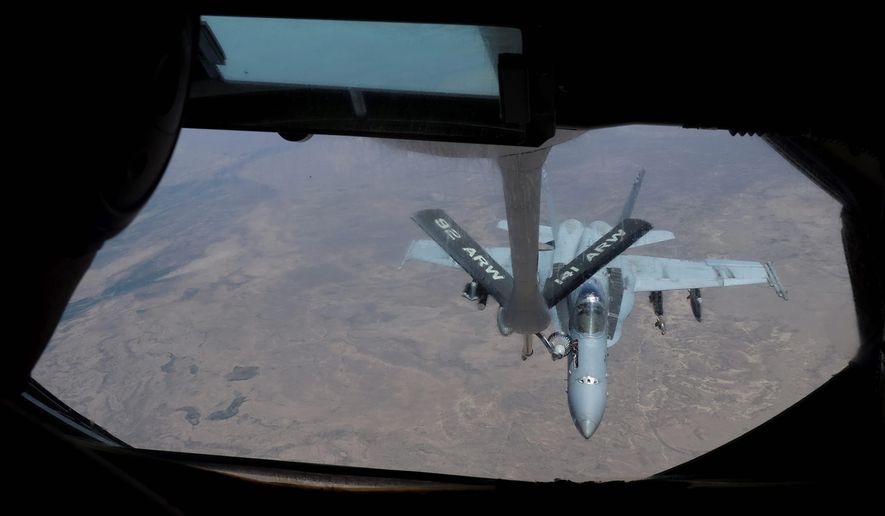WASHINGTON (AP) - In an emphatic defense of the air war in Iraq and Syria, a senior American general is firing back at critics who call the campaign timid and ineffective, saying bombs have tied down Islamic State fighters without killing large numbers of civilians.
In a news conference he said was called to counter misconceptions about the use of air power in an unconventional war, Air Force Lt. Gen. John W. Hesterman III asserted Friday that pilots are killing more than 1,000 militants a month while avoiding civilian casualties and Iraqi government forces.
As the Islamic State has made territorial gains in Anbar province, including the capital Ramadi, critics have accused U.S. commanders of being too cautious, missing opportunities to kill the militants and disrupt their supply lines.
“The thought that we’re observing large numbers of Daesh terrorists and not killing them, anywhere, is fiction,” he said, using an Arabic acronym for the Islamic State, which has defied nearly a year of daily U.S. airstrikes to maintain a hold on large swaths of northern and western Iraq and eastern Syria.
“We kill them wherever we find them,” the general said.
Hesterman leads U.S. Central Command’s air forces and the coalition air campaign. He spoke by telephone to reporters at the Pentagon from his headquarters at al-Udeid air base in Qatar. His remarks followed a wave of skepticism about repeated U.S. assertions that Islamic State fighters are on the defensive in Iraq and Syria, despite evidence to the contrary.
On Friday, Hesterman was on the defensive.
He pushed back, for example, on reports that a U.S. airstrike earlier this week in Hawija, an Islamic State stronghold west of Kirkuk, killed dozens of Iraqi civilians. The U.S. military has acknowledged that it attacked what it said was a facility used to build vehicle-borne suicide bombs but has not confirmed casualties.
Hesterman said “a fairly small weapon” was used against the target, which he described as a known bomb factory in an industrial area. If civilians were killed the blame rests with the Islamic State, he said, for having stored “a massive amount” of high explosives that were ignited by the airstrike.
He said the U.S. will look into the reports of large numbers of civilian deaths. One of four such reports already conducted showed two civilian deaths in Syria by coalition aircraft. The other three have not yet been released.
“Let’s be clear. What did the damage was the huge amount of high explosives that Daesh intended to turn into murderous weapons to kill Iraqi forces and innocent civilians,” Hesterman said. “If there were unintended injuries that responsibility rests squarely on Daesh.”
He more broadly defended the U.S. approach to using air power in Iraq and Syria as the main component of the military campaign.
He mentioned no critics by name, but Sen. John McCain, R-Ariz., chairman of the Senate Armed Services Committee, has complained loudly that the bombing campaign lacks vigor. McCain and others in Congress, as well as some retired military officers, have argued that the campaign could be strengthened by deploying American troops as spotters for airstrikes. In line with a White House policy of not placing American troops in combat danger in Iraq, the Pentagon thus far has avoided putting those “tactical air controllers” in the field with Iraqi ground forces.
Hesterman said such spotters are “always value-added” and are being used away from the front lines.
“Would it be helpful” to have them on the front lines with Iraqi forces? “Probably,” Hesterman said. “Is it necessary? Not so far.”
Hesterman’s assertion that airstrikes are taking more than 1,000 Islamic State fighters off the battlefield each month echoes a claim earlier this week by Tony Blinken, the deputy secretary of state, that airstrikes have killed 10,000 fighters since last August. Military officials have refused to say how they calculate that number, while critics say that even if it is accurate it says little about progress toward defeating IS, which has refilled its ranks with new recruits.
Asked about the perception among many in Washington and elsewhere that a well-financed and adaptive Islamic State army is on the march in Iraq and Syria and that the U.S. military strategy is failing, Hesterman said the perception is based on a flawed notion of how air power should be used.
He said the bombing campaign should not be compared to past wars because the adversary is neither a state nor an established army.
“The comparison is not valid,” he said, adding, “This enemy wrapped itself around the civilian population before we even started.” The military has never had a blueprint for how to use airstrikes in such a setting. “With this enemy we have to be available 24/7 with coalition air power, differentiate them from the population and go after them every time we find them. It’s an order of magnitude more difficult than what we’ve done before.”




Please read our comment policy before commenting.